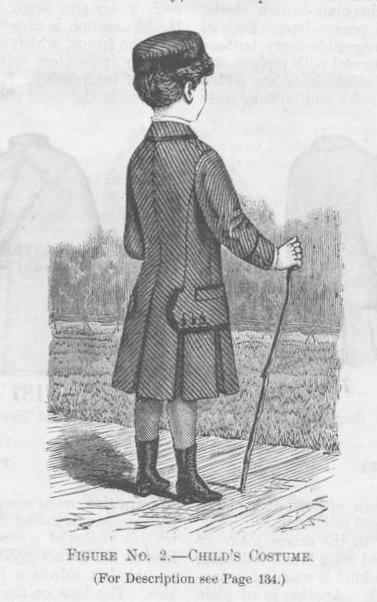
The Delineator Chronology: Child's Suit-styled Dress (September 1880)

Figure 1.-- As was common at the time, "costume" is used to describe the garment rather than a more descriptive term that would help classify the garment. The garment is made to look similar to a kilt suit, but is a one piece garment. Thus it is a dress. We might describe it as a dress in suit form. The ad copy does not speify a boy or girl so presumably it could be worn by either. It may have been more popular for boys, but we are not certain about this.
|
|
This article appeared on page 134--page 135 of the Dileneator September 1980 issue. The illustration was on page 136. As was common at the time, "costume" is used to describe the garment rather than a more descriptive term that would help classify the garment. The Dileneator goes in to great detail about the construction of the garment, but really never tells us just what it is. The garment is made to look similar to a kilt suit, but is a one piece garment. Thus it is a dress. We might describe it as a dress in suit form. The ad copy does not speify a boy or girl so presumably it could be worn by either. It may have been more popular for boys, but we are not certain about this. The Delineator text read:
"Figure No. 2--The costume illustrated is made of fine black-and-white diagonal corduroy, and is in jacket form, closing to the waist-line with button-holes and buttons. They are fitted by an under-arm dart {HBC is not sure what this means] in each and have back extensions that are pointed and lapped upon the back. Daintly little welts croos the end of the under arm darts, and three buttons with simulated button-holes are placed along the lower back edge of the jacket-skirt. The latter falls over a widely box-plaited skirt-portion, which joins long, straight backs that also have extra widths so disposed that the effect of box-plaits all around the garment is obtained. The sleeves are in coat shape, and are completed with cuffs simulated with braid, buttons and immitation button holes. Braid is also used to bind the edges of the collar, jacket-portion and welts, and the bottom of the skirt is turned up for a hem. Any other fabric desired may be used in making up the costume, which may be simply finished with machine-stiching. The model is No. 7186, which is in five sizes for children from two to six years of age , and costs 10d or 20 cents. Other views of the model may be seen upon page 136.
The hat is simply a crown Turban, and is made of the cloth and finished with a velvet band. [HBC note: By "simply a crwown" we think the writer means that there was no brim. What he means by Turban we have no idea. It looks rather like a sailor-styled cap to us.] It may be again seen upon page 137. The model is No. 7189., price 3d or 5 cents, and is in four sizes for children from two to eight years of age."
HBC

Navigate the Boys' Historical Clothing Web Site:
[Return to the Main "Delineator" chronology page]
[Return to the Main "Delineator" page]
[Return to the Main U.S. fashion magazine country page]
[Return tp the Main fashion publishing page]
[Return tp the Main U.S. catalog page]
[Introduction]
[Activities]
[Biographies]
[Chronology]
[Clothing styles]
[Countries]
[Topics]
[Bibliographies]
[Contributions]
[FAQs]
[Glossaries]
[Images]
[Links]
[Registration]
[Tools]
[Boys' Clothing Home]
Navigate the Boys' Historical Clothing Web Site:
[Sailor suits]
[Sailor hats]
[Buster Brown suits]
[Eton suits]
[Rompers]
[Tunics]
[Smocks]
[Pinafores]
Created: 12:20 AM 1/11/2008
Last updated: 12:20 AM 1/11/2008



